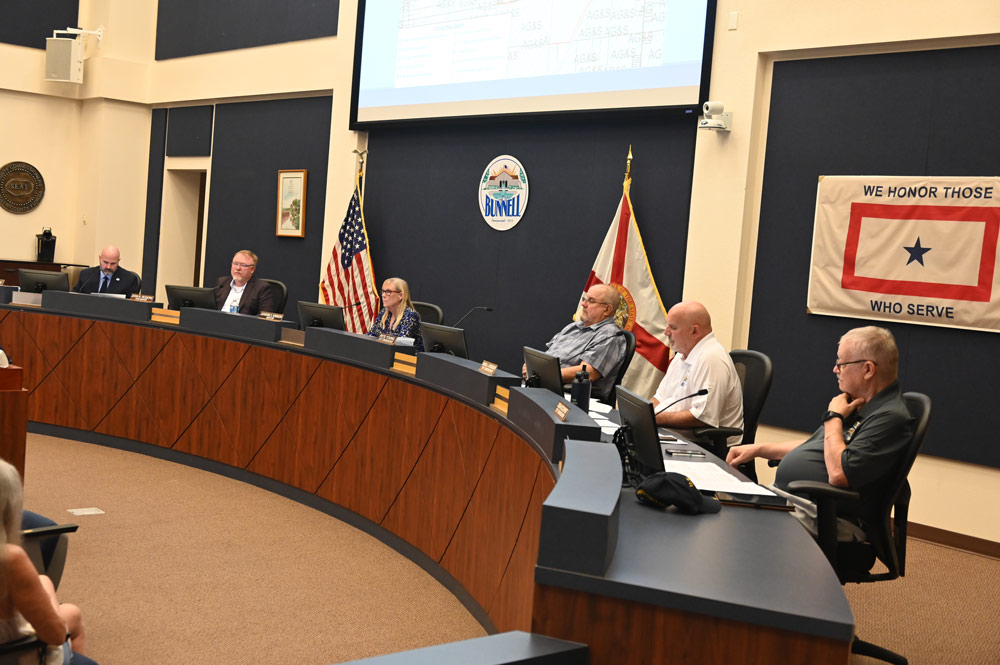
The proposed and controversial rezoning in Bunnell of 1,842 acres from agricultural to industrial designations will be reduced by about 500 acres and requested designations limited to light industrial and heavy industrial, dropping the previous request for agricultural community industrial, the attorney for the landowners said today.
The attorney said the owners are also pledging to make the rezoning conditional on permanent restrictions, so such uses as landfills, fuel depots and hazardous chemical processing would be prohibited. Public opposition had cited all three among its concerns. The “voluntary restriction list” is in the works.
Specific future uses remain unknown, however: there is no end user in mind for now, Tara Tedrow, the attorney representing the landowners, said.
The timberland acreage stretches between Old Haw Creek Road, US Highway 1, and County Road 304. The owners are pledging not to have heavy industrial uses along 304, limiting those to acreage along U.S. 1 and the Florida East Coast Railway line.
The proposed rezoning and an amendment to the city’s comprehensive plan was to go before the Bunnell City Commission on first reading this evening, its size reduced by a few acres. In light of the coming changes, Tedrow says, the item is being pulled from tonight’s agenda and will be resubmitted likely in August.
A protest was planned this evening outside the Government Services Building, ahead of the commission’s 7 p.m. meeting there. A protest two weeks ago drew some 20 people who held up signs to passing traffic along State Rooad 100 (“Save Bunnell No Heavy Industrial,” “Say No to L2,” L2 being the land use code for heavy industrial, and a few rather xenophobic “Stop Moving to Florida” signs.) The protesters drew mostly favorable responses as drivers gestured their thumbs up or honked.
Both regulatory steps went before the Bunnell planning board in early May and won the board’s recommendations on a pair of 3-1 votes, with member Lyn Rafferty, a principal landowners, recusing herself from the vote. The planning board was not inquisitive. But public opposition was significant.
“We had discussions with the city staff,” Tedrow said, “and based on the comments that had come out of the planning and zoning hearing and some of the feedback that transpired since that hearing, we wanted to make revisions to the application, and that constituted some significant reductions in acreage, as well as restrictions on specific types of uses and then some other limitations on the development that we are working through.”
The original proposal for the 40 million square feet land was for 639 acres of heavy industrial zoning, 620 acres of light industrial, and 576 acres of agricultural community industrial, a designation that allows for such uses as sheet-metal shops, millwork, culvert manufacturing and the like. In the new submittal, the request for agricultural community industrial will be removed.
The proposals don’t need to go back to the planning board when they are resubmitted to the commission since the changes are a reduction from what was originally submitted. The revised proposal may not lessen public opposition so much as give the landowners more negotiating leverage before the City Commission.
The opposition’s most recurring questions have focused on the size and future uses of the land–why so much industrial, and to whose ends? Tedrow sought to answer both questions today.
When it went before the planning board the proposed rezoning coincided with Palm Coast’s rejection–after Flagler County and Palm Coast governments initially embraced it–of a planned 72-acre fuel depot that was to be built off US. 1. The colossal project would have stored 300,000 barrels of gasoline at the site, next to the railroad but far from water sources other than wells (some of them public wells supplying Palm Coast’s water).
Bunnell residents feared the Belvedere Terminals fuel farm, as it is to be called, would move a bit south onto the newly industrialized land. Though Flagler County officials said that wasn’t the case, Bunnell City Manager Alvin Jackson refused to confirm that the fuel arm wasn’t moving there, adding to speculation. Today’s assertions by Tedrow put that speculation to rest while still leaving questions about future land uses hanging.
“We do not have a specific end user at this time,” the Orlando-based attorney said. “The purpose for the rezoning is to allow for marketability of the project and to create flexibility in a manner that utilizes the current transportation networks that we have available to us,” meaning the railroad and the proximity to U.S. 1 and I-95. “I understand that folks think that there is definitely an end user in mind. I can assure you, if that were the case, we would be coming with a site plan so that we could get everything buttoned up prior to a closing. But we don’t have that end user yet, and most end users are going to want to see some sort of zoning in place prior to going down the path of doing extensive and expensive due diligence and negotiating contracts on the property.”
The landowners–long-time residents of Bunnell and Flagler County–have been the target of sharp and at times personal criticism in relatively close-knit Bunnell. They are framing the proposal as a benefit to the county’s economic development, and drawing criticism for it, as when some opponents brought a 2019 social media statement by Lafferty, laminated on a large poster board, highlighting her then-opposition to land use surprises along Old Haw Creek.
“My fear is that they are trying to sneak a commercial park into this area,” Lafferty’s post read. “The area surrounding this is ag land and will either remain that or one day become residential, and what they are doing isn’t consistent with the current or future use.” She urged opposition and added, “We can’t just have people buying acreage for ‘their homes’ and then sneaking in a different use and negatively affecting the surrounding aesthetic value. This would set a precedent for any land in the county zoned Ag to suddenly have a business parked on it.”
Further pushback is expected even when the industrial rezoning is resubmitted. “That’s true for anything that you submit in terms of a future land use and zoning change, you can always find somebody who doesn’t like what you are proposing,” Tedrow said. “We would never have growth, and we would never have development if we had to have every project be a popularity contest in terms of allowability of uses. But that’s why we look at things from a different perspective, not just what the public generally likes or wants to see on a project, but also what the comprehensive plan says, what the zoning code says, what long term growth is envisioned by local governments. And then we make those decisions during public hearings, right? So I’m hopeful that the changes that we have made will address some of the overarching concerns that we have heard expressed from the beginning.”





























Jay Tomm says
What part of NO does that developer not understand?
Lance Carroll says
Lyn Lafferty should not be taken at face value.
There are others as well…
Billy says
Flagler county residents are be played like a old fiddle! Lol
Using Common Sense says
It is the HEAVY INDUSTRIAL that is INCOMPATIBLE with the single-family homes, estate properties, and agricultural uses in this area. An environmental disaster waiting to happen, a threat to the fragile ecosystem, and an infringement upon the rights of the local residents to quality of life, safety, health, and welfare. NO THANK YOU to HEAVY INDUSTRIAL zoning!